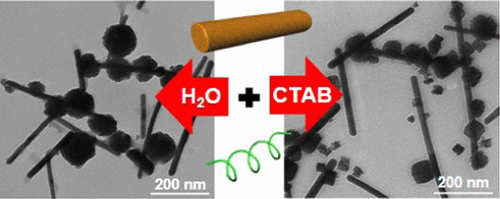当前位置:
X-MOL 学术
›
J. Phys. Chem. C
›
论文详情
Our official English website, www.x-mol.net, welcomes your feedback! (Note: you will need to create a separate account there.)
Peptide Controlled Assembly of Palladium Nanoparticles on High-Aspect-Ratio Gold Nanorods
The Journal of Physical Chemistry C ( IF 3.7 ) Pub Date : 2020-12-02 , DOI: 10.1021/acs.jpcc.0c07653 John Tyler Wagner 1, 2 , Analeece K. Long 1 , Michael B. Sumner 1 , Ivan Cockman 1, 3 , Marvin Smith 1, 4 , Beverly Briggs Penland 1
The Journal of Physical Chemistry C ( IF 3.7 ) Pub Date : 2020-12-02 , DOI: 10.1021/acs.jpcc.0c07653 John Tyler Wagner 1, 2 , Analeece K. Long 1 , Michael B. Sumner 1 , Ivan Cockman 1, 3 , Marvin Smith 1, 4 , Beverly Briggs Penland 1
Affiliation

|
The use of gold nanorods as a template for bimetallic applications, including plasmonics, imaging, and phototherapy, is widely studied due to the unique optical properties of the gold materials. Generally, gold nanorods prepared with a Ag-assisted method are used, with a typical aspect ratio (length vs width) around 3, resulting in surface plasmons resonating within the UV–visible range. Due to these unique properties, gold nanorods are often combined with a catalytically active second metal to increase their range of applicability. The use of higher-aspect-ratio gold nanorods as a bimetallic template is an attractive alternative to the typical method as the longitudinal plasmon of these materials can be adjusted into the near-infrared (NIR) range. This adjustment expands the applications of bimetallic Au nanorods in the second-NIR biological window, which spans 1000–1700 nm. In this work, a materials-binding peptide, CPd4, is used to control the size and shape formation of palladium nanoparticles onto the surface of high-aspect-ratio gold nanorods. Through variation of the solvent used when attaching the peptide, the concentration of CPd4 retained on the nanorods can be manipulated. Higher concentrations of peptide, once palladium was added, were seen to result in smaller cubelike nanoparticles on the surface, whereas lower concentrations of peptide yielded larger spherical palladium nanoparticles. The ability to tune the size and shape of palladium nanorods on the gold nanorod surface allows for optimization of catalytic activity with applications in the NIR range.
中文翻译:

高纵横比金纳米棒上钯纳米粒子的肽控制组装。
由于金材料的独特光学特性,人们广泛研究了将金纳米棒用作双金属应用(包括等离子,成像和光疗)的模板。通常,使用通过银辅助方法制备的金纳米棒,其典型的长径比(长度与宽度)约为3,导致表面等离振子在UV可见范围内共振。由于这些独特的特性,金纳米棒通常与具有催化活性的第二金属结合使用,以增加其适用范围。使用纵横比较高的金纳米棒作为双金属模板是典型方法的一种有吸引力的替代方法,因为这些材料的纵向等离激元可以调节到近红外(NIR)范围内。这项调整扩大了双金属金纳米棒在第二个近红外生物窗口中的应用,该窗口跨度为1000-1700 nm。在这项工作中,材料结合肽CPd4用于控制高纵横比金纳米棒表面上钯纳米颗粒的大小和形状形成。通过改变连接肽时使用的溶剂,可以控制保留在纳米棒上的CPd4的浓度。一旦添加钯,较高浓度的肽被认为在表面上产生较小的立方体状纳米颗粒,而较低浓度的肽产生较大的球形钯纳米颗粒。调节金纳米棒表面上的钯纳米棒的尺寸和形状的能力允许优化在NIR范围内的应用的催化活性。跨度为1000-1700 nm。在这项工作中,材料结合肽CPd4用于控制高纵横比金纳米棒表面上钯纳米颗粒的大小和形状形成。通过改变连接肽时使用的溶剂,可以控制保留在纳米棒上的CPd4的浓度。一旦添加钯,较高浓度的肽被认为在表面上产生较小的立方体状纳米颗粒,而较低浓度的肽产生较大的球形钯纳米颗粒。调节金纳米棒表面上的钯纳米棒的尺寸和形状的能力允许优化在NIR范围内的应用的催化活性。跨度为1000-1700 nm。在这项工作中,材料结合肽CPd4用于控制高纵横比金纳米棒表面上钯纳米颗粒的大小和形状形成。通过改变连接肽时使用的溶剂,可以控制保留在纳米棒上的CPd4的浓度。一旦添加钯,较高浓度的肽被认为在表面上产生较小的立方体状纳米颗粒,而较低浓度的肽产生较大的球形钯纳米颗粒。调节金纳米棒表面上的钯纳米棒的尺寸和形状的能力允许优化在NIR范围内的应用的催化活性。用于控制高纵横比金纳米棒表面上钯纳米颗粒的尺寸和形状形成。通过改变连接肽时使用的溶剂,可以控制保留在纳米棒上的CPd4的浓度。一旦添加钯,较高浓度的肽被认为在表面上产生较小的立方体状纳米颗粒,而较低浓度的肽产生较大的球形钯纳米颗粒。调节金纳米棒表面上的钯纳米棒的尺寸和形状的能力允许优化在NIR范围内的应用的催化活性。用于控制高纵横比金纳米棒表面上钯纳米颗粒的尺寸和形状形成。通过改变连接肽时使用的溶剂,可以控制保留在纳米棒上的CPd4的浓度。一旦添加钯,较高浓度的肽被认为在表面上产生较小的立方体状纳米颗粒,而较低浓度的肽产生较大的球形钯纳米颗粒。调节金纳米棒表面上的钯纳米棒的尺寸和形状的能力允许优化在NIR范围内的应用的催化活性。一旦添加钯,较高浓度的肽被认为在表面上产生较小的立方体状纳米颗粒,而较低浓度的肽产生较大的球形钯纳米颗粒。调节金纳米棒表面上的钯纳米棒的尺寸和形状的能力允许优化在NIR范围内的应用的催化活性。一旦添加钯,较高浓度的肽被认为在表面上产生较小的立方体状纳米颗粒,而较低浓度的肽产生较大的球形钯纳米颗粒。调节金纳米棒表面上的钯纳米棒的尺寸和形状的能力允许优化在NIR范围内的应用的催化活性。
更新日期:2020-12-17
中文翻译:

高纵横比金纳米棒上钯纳米粒子的肽控制组装。
由于金材料的独特光学特性,人们广泛研究了将金纳米棒用作双金属应用(包括等离子,成像和光疗)的模板。通常,使用通过银辅助方法制备的金纳米棒,其典型的长径比(长度与宽度)约为3,导致表面等离振子在UV可见范围内共振。由于这些独特的特性,金纳米棒通常与具有催化活性的第二金属结合使用,以增加其适用范围。使用纵横比较高的金纳米棒作为双金属模板是典型方法的一种有吸引力的替代方法,因为这些材料的纵向等离激元可以调节到近红外(NIR)范围内。这项调整扩大了双金属金纳米棒在第二个近红外生物窗口中的应用,该窗口跨度为1000-1700 nm。在这项工作中,材料结合肽CPd4用于控制高纵横比金纳米棒表面上钯纳米颗粒的大小和形状形成。通过改变连接肽时使用的溶剂,可以控制保留在纳米棒上的CPd4的浓度。一旦添加钯,较高浓度的肽被认为在表面上产生较小的立方体状纳米颗粒,而较低浓度的肽产生较大的球形钯纳米颗粒。调节金纳米棒表面上的钯纳米棒的尺寸和形状的能力允许优化在NIR范围内的应用的催化活性。跨度为1000-1700 nm。在这项工作中,材料结合肽CPd4用于控制高纵横比金纳米棒表面上钯纳米颗粒的大小和形状形成。通过改变连接肽时使用的溶剂,可以控制保留在纳米棒上的CPd4的浓度。一旦添加钯,较高浓度的肽被认为在表面上产生较小的立方体状纳米颗粒,而较低浓度的肽产生较大的球形钯纳米颗粒。调节金纳米棒表面上的钯纳米棒的尺寸和形状的能力允许优化在NIR范围内的应用的催化活性。跨度为1000-1700 nm。在这项工作中,材料结合肽CPd4用于控制高纵横比金纳米棒表面上钯纳米颗粒的大小和形状形成。通过改变连接肽时使用的溶剂,可以控制保留在纳米棒上的CPd4的浓度。一旦添加钯,较高浓度的肽被认为在表面上产生较小的立方体状纳米颗粒,而较低浓度的肽产生较大的球形钯纳米颗粒。调节金纳米棒表面上的钯纳米棒的尺寸和形状的能力允许优化在NIR范围内的应用的催化活性。用于控制高纵横比金纳米棒表面上钯纳米颗粒的尺寸和形状形成。通过改变连接肽时使用的溶剂,可以控制保留在纳米棒上的CPd4的浓度。一旦添加钯,较高浓度的肽被认为在表面上产生较小的立方体状纳米颗粒,而较低浓度的肽产生较大的球形钯纳米颗粒。调节金纳米棒表面上的钯纳米棒的尺寸和形状的能力允许优化在NIR范围内的应用的催化活性。用于控制高纵横比金纳米棒表面上钯纳米颗粒的尺寸和形状形成。通过改变连接肽时使用的溶剂,可以控制保留在纳米棒上的CPd4的浓度。一旦添加钯,较高浓度的肽被认为在表面上产生较小的立方体状纳米颗粒,而较低浓度的肽产生较大的球形钯纳米颗粒。调节金纳米棒表面上的钯纳米棒的尺寸和形状的能力允许优化在NIR范围内的应用的催化活性。一旦添加钯,较高浓度的肽被认为在表面上产生较小的立方体状纳米颗粒,而较低浓度的肽产生较大的球形钯纳米颗粒。调节金纳米棒表面上的钯纳米棒的尺寸和形状的能力允许优化在NIR范围内的应用的催化活性。一旦添加钯,较高浓度的肽被认为在表面上产生较小的立方体状纳米颗粒,而较低浓度的肽产生较大的球形钯纳米颗粒。调节金纳米棒表面上的钯纳米棒的尺寸和形状的能力允许优化在NIR范围内的应用的催化活性。



























 京公网安备 11010802027423号
京公网安备 11010802027423号